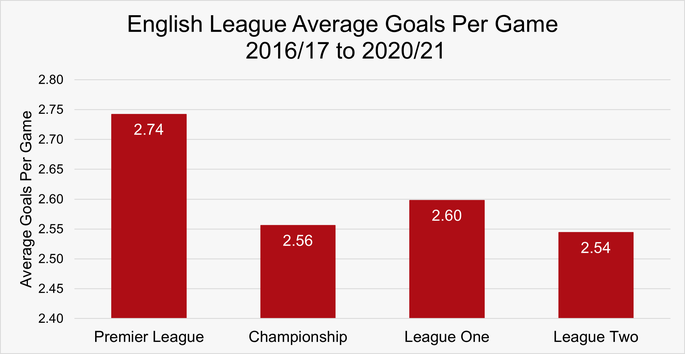 Let’s be honest, most of us watch football because we want to see goals being scored. Yes, those that have played in defence in the past will love to watch a crunching tackle take place and members of the ‘Goalkeeper’s Union’ will be keen to witness a stunning save pulled off in front of them, but general speaking nothing excites football fans more than seeing the ball hit the back of the net and hearing the sound of it ripple.
Let’s be honest, most of us watch football because we want to see goals being scored. Yes, those that have played in defence in the past will love to watch a crunching tackle take place and members of the ‘Goalkeeper’s Union’ will be keen to witness a stunning save pulled off in front of them, but general speaking nothing excites football fans more than seeing the ball hit the back of the net and hearing the sound of it ripple.
The Premier League sells itself as the most exciting league in the world, but does that actually stack up when you consider the number of goals scored in an average match? Elsewhere on this site you can read about how often a Both Teams To Score bet would be a winner, as well as how important home advantage is to the outcome of a game, but neither of those things explore the average number of goals per game.
We’ve taken the number of goals scored in a season and the total number of games played to allow us to figure out the most exciting domestic league in terms of the goals per game. We’ve chosen to look at the Premier League and the English Football Leagues, meaning the Championship, League One and League Two. We’ll look at each of the divisions in turn and, for the purposes of completeness, have chosen to investigate the five seasons between 2016/17 and 2020/21. In terms of the divisions below the Premier League, we are ignoring any play-off matches and instead are limiting our research to the full season proper.
Which English Division Has the Most Goals Per Game?
In the five seasons between 2016-17 and 2020-21, the Premier League had the highest number of goals scored per game with 2.74. League One was next with 2.60 goals per game, closely followed by the Championship with 2.56 and League Two with 2.54.
The Premier League
The English top-flight is considered to be one of the most exciting leagues in Europe. In terms of Both Teams To Score bets, both the German Bundesliga and Italy’s Serie A actually see such wagers win more often than the Premier League does. That doesn’t necessarily mean that it is a league that doesn’t have a wealth of goals scored during the average match, so let’s look at the five seasons in question to find out:
Premier League Average Goals – 2016/17 to 2020/21
| Season | Games | Goals | Average |
|---|---|---|---|
| 2020/21 | 380 | 1024 | 2.69 |
| 2019/20 | 380 | 1034 | 2.72 |
| 2018/19 | 380 | 1071 | 2.82 |
| 2017/18 | 380 | 1018 | 2.68 |
| 2016/17 | 380 | 1064 | 2.80 |
| Total | 1900 | 5211 | 2.74 |
It’s interesting to note that the five seasons aren’t worlds away from each other in terms of the number of goals scored and therefore the average number of goals per game. Indeed, the difference between the 2019-2020 campaign and 2020-2021 season was just ten goals.
Interestingly, the season with the lowest number of goals of 1018 was the season prior to the 2018 World Cup. The highest number of goals with 1071 was the very next season which played after Russia 2018.
The question is, how does that fit in with the rest of the domestic leagues we’re looking at?
The Championship
The sheer number of teams in the Championship means that significantly more games are played during the course of a season. Whilst that obviously won’t make any difference to the average in a literal sense, it does change the ability of teams to stay in good form. The more matches that are played, the more tired attackers become and the less a defence is able to concentrate, so does it lead to more goals scored on average?
There are 24 teams that play their games in the Championship, meaning that there are 552 matches each season. Let’s see how the five seasons compare and if the matches played behind closed doors in 2019/20 and 2020/21 affected these figures.
Championship Average Goals – 2016/17 to 2020/21
| Season | Games | Goals | Average |
|---|---|---|---|
| 2020/21 | 552 | 1274 | 2.31 |
| 2019/20 | 552 | 1457 | 2.64 |
| 2018/19 | 552 | 1473 | 2.67 |
| 2017/18 | 552 | 1409 | 2.55 |
| 2016/17 | 552 | 1441 | 2.61 |
| Total | 2760 | 7054 | 2.56 |
Again, you can see that there’s not much difference in the number of goals scored across four of the five seasons, with the 2020-2021 campaign being the one that stands out. It’s interesting to note that that’s the one that had the majority of matches played behind-closed-doors, perhaps suggesting that goals were harder to come by under those circumstances.
League One
If the Premier League is the most exciting league in the division and the Championship is the league that sees goals scored because of the sheer number of matches played, how does League One compare? Obviously the lower down the footballing pyramid we go, the lower the overall quality of football on offer becomes. Does this lead to more goals because of porous defences, or fewer thanks to less talented attackers?
As with the Championship, League One features 24 teams playing 46 games each with a total of 552 games per season. Lets have a look at the sums in relation to the five seasons in question. The important thing to note here is that not all matches were played in the 2019/20 season. This campaign saw Bury F.C. expelled from the football league without being replaced and was also cut short because of the global crisis. As a result there were only 400 matches played.
League One Average Goals – 2016/17 to 2020/21
| Season | Games | Goals | Average |
|---|---|---|---|
| 2020/21 | 552 | 1447 | 2.62 |
| 2019/20 | 400 | 1044 | 2.61 |
| 2018/19 | 552 | 1462 | 2.65 |
| 2017/18 | 552 | 1401 | 2.54 |
| 2016/17 | 552 | 1417 | 2.57 |
| Total | 2608 | 6771 | 2.60 |
We’re starting to see now that there isn’t a huge difference from season to season. That is interesting in and of itself, with there being a difference of just 15 goals between the 2018-2019 campaign and the 2020-2021 season, which were the latest two full seasons played out. The average remained roughly the same across all five campaigns, which is why it’s always worth looking at. How does it compare to League Two?
League Two
As with the Championship and League One, the further away from the Premier League you get the more you’d expect the quality of the matches to decline. That doesn’t necessarily mean that goals are definitely going to happen, but you’re likely to see weaker defences and attacks that struggle a bit more to put the ball in the back of the net.
As with League One and the Championship, League Two seasons typically feature 24 teams playing 552 matches. We taken a look at the same five seasons as the division featured above, bearing in mind that the 2019-2020 season was curtailed slightly with only 440 matches played.
League Two Average Goals – 2016/17 to 2020/21
| Season | Games | Goals | Average |
|---|---|---|---|
| 2020/21 | 552 | 1303 | 2.36 |
| 2019/20 | 440 | 1108 | 2.52 |
| 2018/19 | 552 | 1409 | 2.55 |
| 2017/18 | 552 | 1458 | 2.64 |
| 2016/17 | 552 | 1465 | 2.65 |
| Total | 2648 | 6743 | 2.55 |
Mirroring the information that we saw in the Championship, there were fewer goals scored on average during the 2020-2021 campaign, which is the one that was played almost entirely behind-closed-doors. It’s a fascinating phenomenon that didn’t seem to affect League One and was only slightly noteworthy in the Premier League, though what that tells us is difficult to know.
Which League Has The Most Goals Per Match?
Having looked at each of the leagues independently, it is now time to compare them side-by-side to see what that tells us about the highest average goals per match in all of them. Is there anything overly surprising when you compare the English leagues against one another with regards to that average?
English League Average Goals – 2016/17 to 2020/21
| Season | Premier League | Championship | League 1 | League 2 |
|---|---|---|---|---|
| 2020/21 | 2.69 | 2.31 | 2.62 | 2.36 |
| 2019/20 | 2.72 | 2.64 | 2.61 | 2.52 |
| 2018/19 | 2.82 | 2.67 | 2.65 | 2.55 |
| 2017/18 | 2.68 | 2.55 | 2.54 | 2.64 |
| 2016/17 | 2.80 | 2.61 | 2.57 | 2.65 |
| Total | 2.74 | 2.56 | 2.60 | 2.54 |
We can see from the final section of the table, which offers us the total average goals scored across the three seasons that we’re looking at, that the Premier League is the English division with the most goals scored. Indeed, it is only really League One that messes up the theory that the lowering quality of the divisions will see fewer goals scored, given that it outscored the Championship on average over our five seasons.

